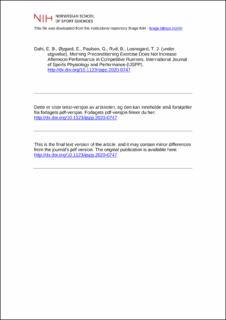| dc.contributor.author | Dahl, Even B. | |
| dc.contributor.author | Øygard, Eivind | |
| dc.contributor.author | Paulsen, Gøran | |
| dc.contributor.author | Rud, Bjarne | |
| dc.contributor.author | Losnegard, Thomas Johansen | |
| dc.date.accessioned | 2021-11-23T08:15:39Z | |
| dc.date.available | 2021-11-23T08:15:39Z | |
| dc.date.created | 2021-09-06T08:55:38Z | |
| dc.date.issued | 2021 | |
| dc.identifier.citation | International Journal of Sports Physiology and Performance (IJSPP). 2021, under utgivelse. | en_US |
| dc.identifier.issn | 1555-0265 | |
| dc.identifier.uri | https://hdl.handle.net/11250/2830867 | |
| dc.description | Dette er siste tekst-versjon av artikkelen, og den kan inneholde små forskjeller fra forlagets pdf-versjon. Forlagets pdf-versjon finner du her: https://doi.org/10.1123/ijspp.2020-0747 / This is the final text version of the article, and it may contain minor differences from the journal's pdf version. The original publication is available here: https://doi.org/10.1123/ijspp.2020-0747 | en_US |
| dc.description.abstract | Purpose: Preconditioning exercise is a widely used strategy believed to enhance performance later the same day. The authors examined the influence of preconditioning exercises 6 hours prior to a time-to-exhaustion (TTE) test during treadmill running. Methods: Ten male competitive runners (age = 26 [3] y, height = 184 [8] cm, weight = 73 [9] kg, maximum oxygen consumption = 72 [7] mL·kg−1·min−1) did a preconditioning session of running (RUN) or resistance exercise (RES) or no morning exercise (NoEx) in a randomized order, separated by >72 hours. The RUN consisted of 15 minutes of low-intensity running and 4 × 15 seconds at race pace (21–24 km·h−1) on a treadmill; RES involved 5 minutes of low-intensity running and 2 × 3 repetitions of isokinetic 1-leg shallow squats with maximal mobilization. Following a 6-hour break, electrically evoked force (m. vastus medialis), countermovement jump, running economy, and a TTE of approximately 2 minutes were examined. Results: Relative to NoEx, no difference was seen for RUN or RES in TTE (mean ± 95% CI: −1.3% ± 3.4% and −0.5% ± 6.0%) or running economy (0.2% ± 1.6% and 1.9% ± 2.7%; all Ps > .05). Jump height was not different for the RUN condition (1.0% ± 2.7%]) but tended to be higher in RES than in the NoEx condition (1.5% ± 1.6%, P = .07). The electrically evoked force tended to reveal low-frequency fatigue (reduced 20:50-Hz peak force ratio) only after RES compared to NoEx (−4.5% ± 4.6%, P = .06). Conclusion: The RUN or RES 6 hours prior to approximately 2 minutes of TTE running test did not improve performance in competitive runners. | en_US |
| dc.language.iso | eng | en_US |
| dc.subject | endurance | en_US |
| dc.subject | morning exercise | en_US |
| dc.subject | running economy | en_US |
| dc.subject | strength training | en_US |
| dc.subject | prior exercise | en_US |
| dc.subject | warm-up | en_US |
| dc.title | Morning Preconditioning Exercise Does Not Increase Afternoon Performance in Competitive Runners | en_US |
| dc.type | Peer reviewed | en_US |
| dc.type | Journal article | en_US |
| dc.description.version | acceptedVersion | en_US |
| dc.source.pagenumber | 8 | en_US |
| dc.source.journal | International Journal of Sports Physiology and Performance (IJSPP) | en_US |
| dc.identifier.doi | 10.1123/ijspp.2020-0747 | |
| dc.identifier.cristin | 1931444 | |
| dc.description.localcode | Institutt for fysisk prestasjonsevne / Department of Physical Performance | en_US |
| cristin.ispublished | true | |
| cristin.fulltext | postprint | |
| cristin.qualitycode | 1 | |
